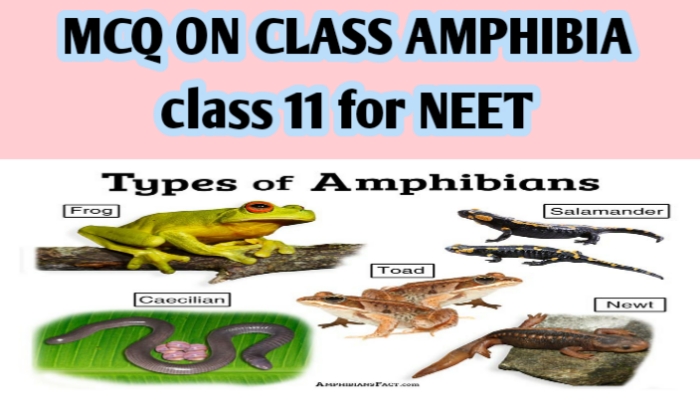MCQ ON CLASS AMPHIBIA class 11 for NEET | MCQ ON NEET Biology class 11th 2022 | MCQ Questions for class 11 Biology chapter – 4 CLASS AMPHIBIA with Answer | Check the below NCERT MCQ question for class 11 Biology chapter 4 based on CLASS AMPHIBIA with Answers.

MCQ ON CLASS AMPHIBIA class 11 for NEET
MCQ Questions for class 11 Biology with Answers were prepared based on the latest pattern.We have provided class 11 Biology MCQs questions on CLASS AMPHIBIA with Answers to help students understand the concept very well.
MCQ on CLASS AMPHIBIA is useful for NEET / CSIR / UGC / CBSE / ICSE / AIIMS / EXAM / AFMC EXAM / STATE LEVEL MEDICAL EXAM 2022-23
Introduction:- Class amphibians can live in aquatic as well as terrestrial habitats .Most of them have two pairs of limbs. Body is divisible into head and trunk .Tail may be present in some.The amphibians skin is moist without scales. The eyes have eyelids. A tympanum represents the ear . Alimentary canal , urinary , and reproductive tracts open into a common chamber called cloaca which opens to the exterior.Respiration is by gills, lungs lungs and through skin.
MCQ ON CLASS AMPHIBIA class 11 for NEET
1. Animals can live in aquatic as well as terrestrial habitat
(a) amphibians
(b) aves
(c) reptiles
(d) all the above
Ans (a) amphibians
2. The amphibians skin is
(a) moist with scales
(b) moist without scales
(c) dry without scales
(d) all the above
Ans. (b) moist without scales
3. A tympanum in amphibians represents
(a) eye
(b) ear
(c) nose
(d) all the above
Ans. (b) ear
4. In amphibians alimentary canal , urinary , and reproductive tracts open into a common chamber called
(a) tympanum
(b) cloaca
(c) operculum
(d) all the above
Ans.(b) cloaca
5.Respiration in amphibians is done by
(a) gills
(b) lungs
(c) skin
(d) all the above
Ans.(d) all the above
ALSO READ:-
● YOU CAN WATCH BIOLOGY SIR Youtube channel
6.The heart is three chambered two auricles and one ventricle in
(a) reptiles
(b) aves
(c) amphibians
(d) all the above
Ans.(c) amphibians
7. Toad is
(a) bufo
(b) rana
(c) hyla
(d) salamandra
Ans.(a) bufo
8. The tree frog is
(a) hyla
(b) salamandra
(c) bufo
(d) all the above
Ans.(a) hyla
9. Limbless amphibia
(a) bufo
(b) rana
(c) hyla
(d) ichthyophis
Ans. (d) ichthyophis
10. Bufo , rana , hyla are example of
(a) amphibia
(b) osteichthyes
(c) chondrichthyes
(d) hemichordata
Ans. (a) amphibia
11. The features of amphibians are
(a) sexes are separate
(b) fertilisation is external
(c) they are oviparous
(d) all the above
Ans.(d) all the above
12. Which are features of amphibia ?
(a) they are oviparous
(b) these are cold blooded
(c) development is indirect
(d) all the above
Ans.(d) all the above
13. Cranial nerves found in amphibia is
(a) 9 pairs
(b) 10 pairs
(c) 11 pairs
(d) all the above
Ans.(b) 10 pairs
14. Age of amphibians is ?
(a) Jurassic
(b) Carboniferous
(c) Devonian
(d) all the above
Ans.(b) Carboniferous
15. The apoda , urodela and anura are subclasses of
(a) amphibians
(b) reptiles
(c) aves
(d) all the above
Ans. (a) amphibians
16. The flying frog is?
(a) rhacophorus
(b) xenopus
(c) alytes
(d) none
Ans.(a) rhacophorus
17. The common Indian frog is
(a) rana tigrina
(b) triturus
(c) urodela
(d) all the above
Ans.(a) rana tigrina
18. The Himalayan salamander is
(a) triturus
(b) anura
(c) necturus
(d) all the above
And.(a) triturus
19. The indian toad is
(a) scoliodon
(b) bufo malanostictus
(c) pristis
(d) all the above
Ans. (b) bufo malanostictus
20. The first vertebrate to have a true tongue
(a) reptiles
(b) aves
(c) amphibians
(d) all the above
Ans.(c) amphibians







Leave a Comment